
The global economic order, characterised by liberal trade and U.S.-centric financial institutions, is undergoing seismic shifts due to the U.S. -China trade war in 2018. The tariff truce between these superpowers, while easing market volatility, still highlights the ongoing struggle for technological supremacy and geoeconomic influence. For India, the truce presents a paradox, restores short-term trade stability but also exacerbates long-term vulnerabilities unless addressed with structural reforms and diplomatic foresight. As an emerging pole in the Indo-Pacific, India’s response will determine whether it remains a reactive trading entity or evolves into a proactive geoeconomic actor.
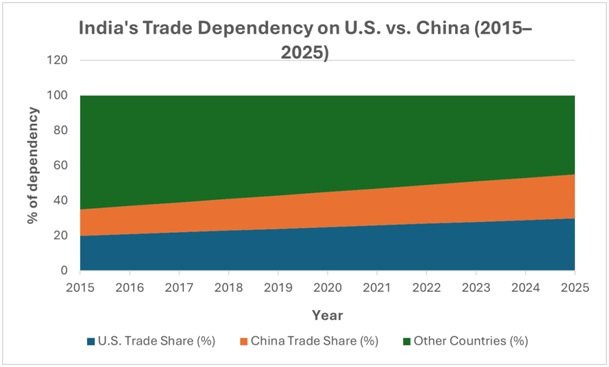
De-dollarisation Effects in the World & China’s Dominance
The de-dollarisation of global trade is driven by dissatisfaction with the current international financial architecture, with countries like Russia, China, Brazil, and the UAE exploring alternative payment mechanisms. China’s promotion of the digital yuan and the establishment of the Cross-Border Interbank Payment System aim to reduce reliance on the SWIFT network and challenge dollar hegemony. This movement, accelerated by geopolitical sanctions and U.S. fiscal policy vulnerabilities, has strategic implications for India. While it provides opportunities to settle trade in rupees with countries like Russia and the UAE, it also risks deepening China’s financial influence in Asia and Africa.[1] India must champion a multilateral, rules-based alternative anchored in digital sovereignty and regional currency cooperation.
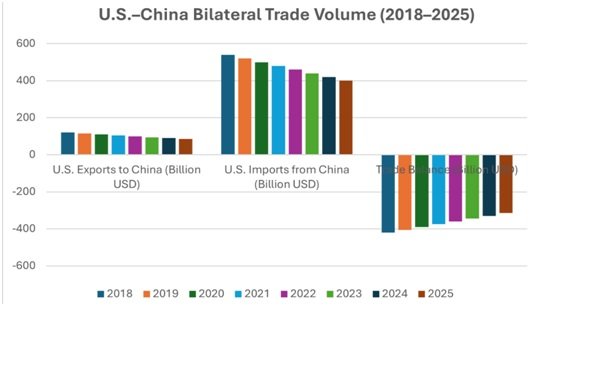
U.S-China Chip War and Its Impacts on India’s Strategic Interests
The United States’ ban on exporting sophisticated chips to China, which aims to slow down China’s achievements in AI and quantum technology, is upsetting the global semiconductor supply chain. For India, this “chip war” presents both chances and risks. India’s electronics and automotive sectors may be at risk from disruptions in the global semiconductor supply chain. But US allies are also pursuing India as a possible substitute in the global semiconductor value chain. India’s growing significance is demonstrated by the Micron semiconductor project in Gujarat and collaborations with Applied Materials and Lam Research. More than assembly-line involvement is required for India’s strategic interests,[2] and the chip battle must spur an indigenous R&D ecosystem backed by strategic alliances and state-led incentives.
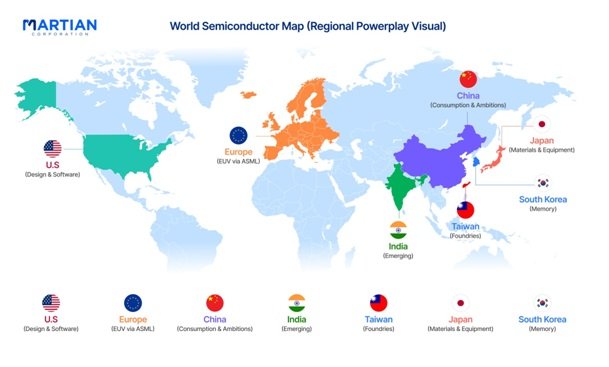
Source: https://www.linkedin.com/pulse/silicon-showdown-global-powerplay-chip-supremacy-i6loc/
India-U.S. Trade Equation: Short-Term Relief, Long-Term Challenges
The tariff truce offers India temporary relief by stabilising global supply chains and preventing excessive inflationary pressure in trade-dependent sectors like electronics and textiles. During the peak of U.S. -China tensions, Indian firms benefited from export diversions, particularly in chemicals, pharmaceuticals, and mobile manufacturing. Yet, this advantage is unlikely to be permanent. With the easing of tariffs, Chinese manufacturers may reclaim market share through aggressive under-pricing, especially in U.S. consumer markets. India’s dependence on Chinese imports, particularly in telecom gear, APIs, and rare earths, has also increased, widening the trade deficit. Moreover, India’s bilateral trade engagement with the U.S., though strategically vital, is marked by structural asymmetries.[3] U.S. digital firms dominate India’s digital economy while market access for Indian services, pharmaceuticals, and textiles remains constrained by tariff and non-tariff barriers. India must negotiate these asymmetries not only as a trade issue but as a strategic trust deficit in the Indo-Pacific economic architecture.
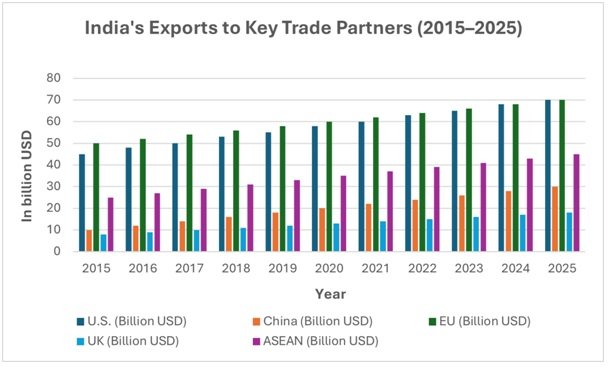
India’s Strategic Technologies and Semiconductor Diplomacy
India’s foray into strategic technologies must be viewed as an effort to enhance national power in a multipolar, tech-centric world order. Through the India-U.S. Initiative on Critical and Emerging Technologies (iCET), India aims to integrate into trusted technology supply chains. Semiconductor diplomacy is now central to this effort. The government’s “Semicon India” initiative seeks to build a complete chip ecosystem ranging from silicon fabs to assembly, testing, and packaging units. However, the real test lies in securing access to proprietary technologies and reducing external dependency. The U.S’s continued export controls on critical chip-making equipment to India due to Tier-2 classification under export control regimes undermines this trust-based collaboration.[4] India must therefore internationalise its technology diplomacy, forging flexible coalitions with like-minded democracies like Japan, South Korea, EU while strengthening domestic institutions like Semiconductor Laboratoryand DRDO’s Microelectronics Division. Strategic autonomy in technology is not a luxury; it is a geopolitical necessity.
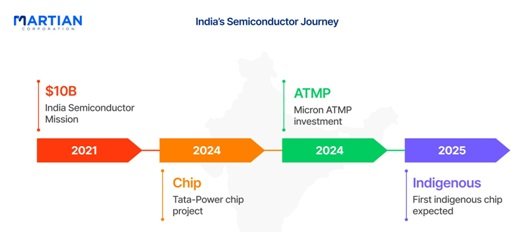
Source: https://www.linkedin.com/pulse/silicon-showdown-global-powerplay-chip-supremacy-i6loc/
India’s Digital and AI Ambitions
India’s AI ambitions are hindered by a critical deficit in computing power, despite having a vast talent pool. The country lacks access to high-end AI chips like NVIDIA’s A100/H100, which are restricted by U.S. export controls.[5] Despite initiatives like IndiaAI and the National AI Compute Infrastructure, this technological denialism contradicts India-U.S. strategic cooperation. To rectify this, India must combine technology access with digital sovereignty, invest in open-source AI, build national data lakes for model training, and expand public-private R&D partnerships.[6] As AI becomes the currency of future geopolitical influence, India’s ability to shape norms, ethics, and access will determine its status as a digital power.
Institutionalising Geoeconomic Preparedness of India’s Trade Response Mechanisms
India’s strategy should balance structural resilience with strategic hedging. Diversity is crucial for markets and sourcing, reducing dependence on the US and China. Expanding free trade agreements with the EU, UK, and Australia, along with deeper participation in plurilateral organisations, is essential. India should promote reciprocal tech access under export regulations, and Washington should recognise its strategic importance by granting it Tier-1 status in export controls and stepping up defence-industrial cooperation. India should also create economic statecraft agencies like the U.S. Bureau of Industry and Security.The National Security Council Secretariat (NSCS), MEA, and Ministry of Commerce must act in sync.[7] Finally, India should assert its vision of a fair digital and trade order at multilateral forums like the WTO, UN-ESCAP, and G20 positioning itself as a voice of the Global South, advocating for democratic digital ecosystems, equitable trade rules, and tech pluralism.
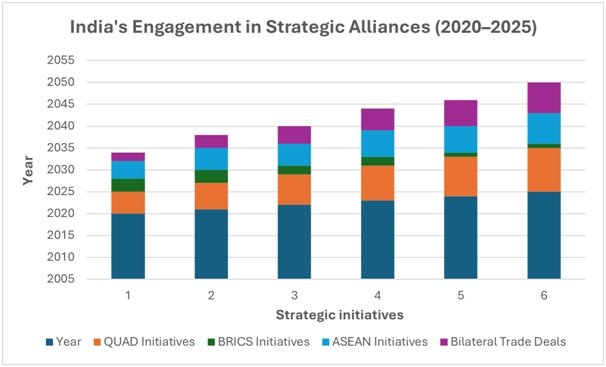
Conclusion
The turbulence in global trade is characterised by protectionism and strategic tariff weaponisation. India, with deep economic ties to the U.S. and China, must navigate this complex terrain with strategic foresight. Strengthening partnerships through platforms like the QUAD, advancing bilateral trade agreements, and accelerating domestic manufacturing and digital reforms can help India reposition itself as a resilient player. By prudent alignment, calculated negotiation, and targeted investments in critical technologies, India can shape the global order.
Endnotes:
[1] Saaida, M. (2024). BRICS Plus: De-dollarization and global power shifts in new economic landscape. BRICS Journal of Economics, 5(1), Article 1. https://doi.org/10.3897/brics-econ.5.e117828
[2] Phanase, P. (2024, July 4). The Strategic Implications of Chip War for India – CENJOWS. https://cenjows.in/the-strategic-implications-of-chip-war-for-india/
[3] Hasan Khan, K. (2025, April 4). The India-US Trade Dilemma: Tariffs, Tensions, and the Road Ahead. https://thediplomat.com/2025/04/the-india-us-trade-dilemma-tariffs-tensions-and-the-road-ahead/
[4] Mishra, R., & Prajapati, H. (2024, October 2). The Foreign Policy Connections of India’s Semiconductor Strategy. https://thediplomat.com/2024/10/the-foreign-policy-connections-of-indias-semiconductor-strategy/
[5] Wang, C.-J. (2024, June 28). 4 Ways China Gets Around US AI Chip Restrictions. https://thediplomat.com/2024/06/4-ways-china-gets-around-us-ai-chip-restrictions/
[6] Chaudhuri, R., & Mohanty, A. (2025, April 22). The India-U.S. TRUST Initiative: A Policy Roadmap for Accelerating AI Infrastructure. Carnegie Endowment for International Peace. https://carnegieendowment.org/posts/2025/04/the-india-us-trust-initiative-the-us-india-roadmap-on-accelerating-ai-infrastructure-a-policy-agenda?lang=en
[7] V Pant, H., & Vivek, M. (2025). INDIA THINK TANK FORUM 2025: Shaping a Resilient Global Order. https://www.orfonline.org/public/uploads/posts/pdf/20250525225814.pdf
Leave a Reply